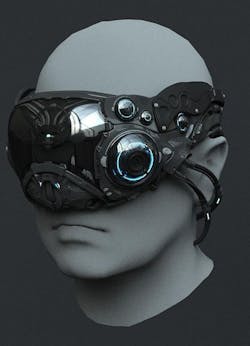First Odor-Enhanced VR Headset Goes on Sale in Time for the Holidays
This article is part of the 2022 April 1st series in the Humor topic within our Series Library.
Digitally synthesized odors (DSOs) promise to bring a new dimension of realism to virtual reality, allowing virtual travelers to breathe in the heady aromas of downtown Mumbai, and make it possible for gamers to smell an enemy lurking behind them. At least one manufacturer is aiming to bring a first-generation olfactory-enhanced (OE) headset to market in time for the 2022 holiday season, despite setbacks caused by two competing DSO technologies competing to dominate this emerging market (Fig. 1).
Born in Battle
Digital odor synthesis was invented in the mid-1990s as part of a DARPA research program and has proven its value in several generations of the U.S. Army's battle training simulators. As reported in the April 1, 1995 issue of Electronic Design, the original DSO system, developed by Dr. Apri L'Fuhl, was based on a recently discovered class of organic compounds, known as "Primary Odorants (POs)."
While each PO has its own distinctive smell, they can be combined in precise ratios with one or more other POs to create a wide range of completely different scents. Modern DSO systems typically use a small cartridge, containing an array of capsules each containing a different PO compound. Each capsule is equipped with a small heating element and a MEMS-based valve that can precisely meter the compound into a vortex mixing plenum where the desired scent is created.
Thanks to the POs’ unique properties, it takes only takes 32 different compounds to produce tens of thousands of unique odors. When Dr. L'Fuhl's team sought to commercialize the technology in the early 2000s, they introduced a new collection of 64 POs that could produce what they referred to as high-definition digitally synthesized odors (HD-DSOs).
The team also developed the technology for an "artificial nose" that would enable two-way transmission of odors over the internet, a technology commonly referred to as "tele-olfaction.” Unfortunately, the deployment of tele-olfaction became stalled when the IETF found itself in conflict with Microsoft over the development of a standard for communication of odors.
Eventually, the IETF abandoned its efforts and Microsoft's WinSmell 95 drivers became the de facto standard, just before the software giant scuttled the entire project. It was only recently that Microsoft revived its research on the technology and introduced a greatly improved version of the artificial nose (Fig. 2).
An Overnight Success—After 20 Years
The war over transmission standards was one of several reasons that the technology struggled to gain traction in commercial applications for over two decades. Things began to look up during the internet boom of the early 2000s. Several venture capitalists dabbled briefly with tele-olfaction, most notably as an enhancement to the early tele-dildonics systems that were hitting the market. While systems won awards at CES and its companion show, the AVN Expo, a combination of technical and marketing issues kept the technology from achieving critical mass.
In an odd twist of fate, the COVID pandemic has given DSO technology a second life, thanks to a surge in the adoption of virtual reality by tens of millions of homebound workers and consumers. The high volume of VR headsets being sold provided the justification for investing in the R&D needed to commercialize the technology.
YoYo Dyne Entertainment, based in Grover's Mill N.J., was the first company to license the technology. The company created a much smaller, lighter DSO system that could be integrated into a gaming product. The company recently announced that, after successful beta testing of the prototype, its OE-VR headset will be entering production early this summer in a repurposed automotive accessory plant, located just outside Flint, Mich.
"We decided to onshore even before the Ukraine kerfuffle" said John Fish, YoYo Dyne's CBO. "In addition to giving us a shorter, more reliable supply chain, we also have access to a huge community of highly skilled manufacturing monkey-boys—oops, I meant workers. And besides, YoYo Dyne feels it is both our privilege and our duty to give back to the planet, ah, I mean country that has given us so many opportunities.”
Branded as the Overthruster-Full Impact, the OE-VR headset will take its place as the flagship product in YoYo Dyne's 2023 collection of its iconic Overthruster series of gaming gear. With a retail price of $799.42, it will come with a basic 32-odorant cartridge, suitable for general-purpose use. The company also will be introducing a series of specialized cartridges that can be used to further enhance specific applications.
"We'd anticipated that there would be a big demand for a high-def cartridge that could create exotic odors to complement the alien landscapes that players encounter in many science-fiction-based VR games" said John Bigbooty, YoYo Dyne's VP of marketing. "We also expect our 'Smell the World' cartridge to be very popular, especially, if Heaven forbid, another nasty COVID variant forces us back into lockdown.”
The VP hefted one of the first production units in his hand and grinned. "The funny thing about this launch is that we were completely surprised when our focus groups identified a large percentage of former office workers who now work remotely who expressed a deep nostalgia for the smells of their old workplace,” said Bigbooty. “To meet this demand, we developed the Daily Grind odor cartridge. When combined with a small software app, it can take a remote worker through a full week of the routine and random smells they miss."
"We worked hard to faithfully reproduce the environment that office workers call their comfort zone" continued Bigbooty. "When you log in to work, your Full Impact VR headset will greet you with the smell of fresh-brewed coffee that will become increasingly stale as the day goes on. Your day will also be punctuated by occasional bursts of ozone and toner from a virtual copying machine as well as random whiffs of body odors from your virtual co-workers.
“At lunchtime, Daily Grind's virtual break room will fill the air with the scents of various lunches being microwaved. And, if you happen to work late, you'll be treated to the muffled sound of trash cans being emptied and whiffs of various janitorial products," he concluded.
Read more articles in the 2022 April 1st series in the Humor topic within our Series Library.
About the Author
Lee Goldberg
Contributing Editor
Lee Goldberg is a self-identified “Recovering Engineer,” Maker/Hacker, Green-Tech Maven, Aviator, Gadfly, and Geek Dad. He spent the first 18 years of his career helping design microprocessors, embedded systems, renewable energy applications, and the occasional interplanetary spacecraft. After trading his ‘scope and soldering iron for a keyboard and a second career as a tech journalist, he’s spent the next two decades at several print and online engineering publications.
Lee’s current focus is power electronics, especially the technologies involved with energy efficiency, energy management, and renewable energy. This dovetails with his coverage of sustainable technologies and various environmental and social issues within the engineering community that he began in 1996. Lee also covers 3D printers, open-source hardware, and other Maker/Hacker technologies.
Lee holds a BSEE in Electrical Engineering from Thomas Edison College, and participated in a colloquium on technology, society, and the environment at Goddard College’s Institute for Social Ecology. His book, “Green Electronics/Green Bottom Line - A Commonsense Guide To Environmentally Responsible Engineering and Management,” was published by Newnes Press.
Lee, his wife Catherine, and his daughter Anwyn currently reside in the outskirts of Princeton N.J., where they masquerade as a typical suburban family.


